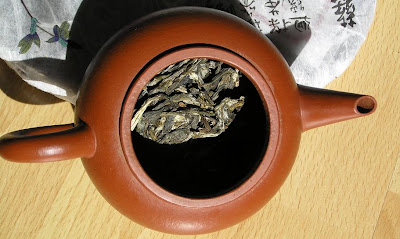I got this tea from Scotts
Yunnan Sourcing LLC more than a year and a half ago. I like the shape of iron cakes so I decided to try this tea. Unfortunately, I was able to purchase only the last piece.
As I wrote, I really like the sharp edges of iron cakes, so that’s why most of the photos here is of the beeng itself. The beeng is Te Ji or best quality grade, but without silver tips. It should have a box – I got it without it and so the cake was broken into two pieces. But hey – I have to break it to drink the tea, so it does not matter too much.

Compression. Well, the Xiaguan is famous for it's compression making granite-hard puerh. And iron cakes are made by hudraulic compression, so I was expected it to be really petrous piece. But when I unpacked the wrapper, I was surprised, how ethereal is this cake. Light and airy, it’s possible to break it by bare hands.


The leaves are small and cute, the cake itself emits very strong and healthy aroma, woody with touch of flowers. Even if this beeng is nearly five years old, it’s still pretty young. Unfortunately, since I like it and drink it a lot, I will probably not see it to mature and age.
On neifei is clearly printed the year when the cake was produced – it’s good for collectors, although I know that faking the neifei is nearly effortless.
I prepared the tea in my sheng pu-erh zhuni teapot, using about 6 grams of leaves in 150 ml water. As always, I started with very short steeping and I gradually prolonged them.
The liquor is light orange, thick and aromatic. The taste is full bodied, but delicate and nimble. It was surprisingly sweet with honey and hint of fruits, resembling dried plums. In those five years the tea lost it’s harshness but still doesn’t developed the aged taste. No smokiness at all, it’s very enjoyable tea right now.

Should I buy this tea again, if it’s available? Certainly! The iron cake form isn’t just very cool, but the tea is tasty, very enjoyable and has a potential to improve.

































